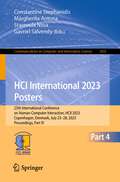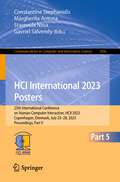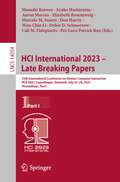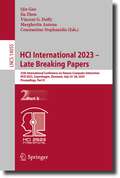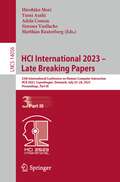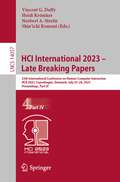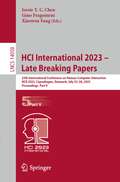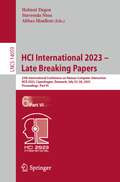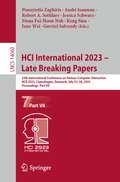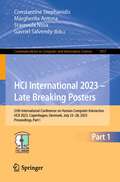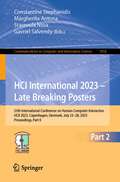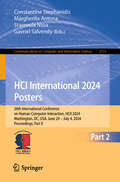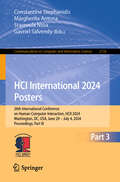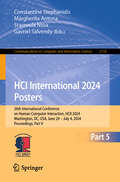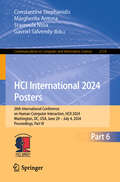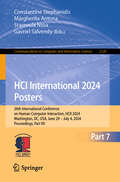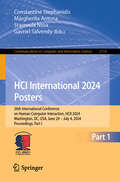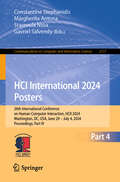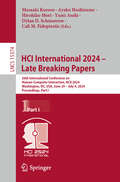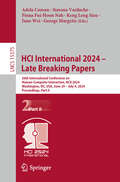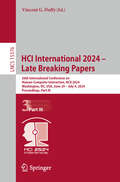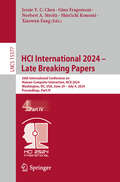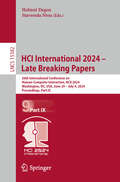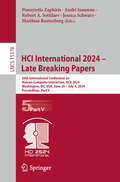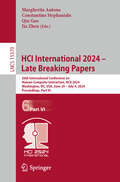- Table View
- List View
HCI International 2023 Posters: 25th International Conference on Human-Computer Interaction, HCII 2023, Copenhagen, Denmark, July 23–28, 2023, Proceedings, Part IV (Communications in Computer and Information Science #1835)
by Gavriel Salvendy Margherita Antona Constantine Stephanidis Stavroula NtoaThe five-volume set CCIS 1832-1836 contains the extended abstracts of the posters presented during the 25th International Conference on Human-Computer Interaction, HCII 2023, which was held as a hybrid event in Copenhagen, Denmark, in July 2023.The total of 1578 papers and 396 posters included in the 47 HCII 2023 proceedings volumes were carefully reviewed and selected from the 7472 contributions.The posters presented in these five volumes are organized in topical sections as follows: Part I: HCI Design: Theoretical Approaches, Methods and Case Studies; Multimodality and Novel Interaction Techniques and Devices; Perception and Cognition in Interaction; Ethics, Transparency and Trust in HCI; User Experience and Technology Acceptance Studies.Part II: Supporting Health, Psychological Wellbeing, and Fitness; Design for All, Accessibility and Rehabilitation Technologies; Interactive Technologies for the Aging Population.Part III: Interacting with Data, Information and Knowledge; Learning and Training Technologies; Interacting with Cultural Heritage and Art.Part IV: Social Media: Design, User Experiences and Content Analysis; Advances in eGovernment Services; eCommerce, Mobile Commerce and Digital Marketing: Design and Customer Behavior; Designing and Developing Intelligent Green Environments; (Smart) Product Design.Part V: Driving Support and Experiences in Automated Vehicles; eXtended Reality: Design, Interaction Techniques, User Experience and Novel Applications; Applications of AI Technologies in HCI.
HCI International 2023 Posters: 25th International Conference on Human-Computer Interaction, HCII 2023, Copenhagen, Denmark, July 23–28, 2023, Proceedings, Part V (Communications in Computer and Information Science #1836)
by Gavriel Salvendy Margherita Antona Constantine Stephanidis Stavroula NtoaThe five-volume set CCIS 1832-1836 contains the extended abstracts of the posters presented during the 25th International Conference on Human-Computer Interaction, HCII 2023, which was held as a hybrid event in Copenhagen, Denmark, in July 2023.The total of 1578 papers and 396 posters included in the 47 HCII 2023 proceedings volumes were carefully reviewed and selected from the 7472 contributions.The posters presented in these five volumes are organized in topical sections as follows: Part I: HCI Design: Theoretical Approaches, Methods and Case Studies; Multimodality and Novel Interaction Techniques and Devices; Perception and Cognition in Interaction; Ethics, Transparency and Trust in HCI; User Experience and Technology Acceptance Studies.Part II: Supporting Health, Psychological Wellbeing, and Fitness; Design for All, Accessibility and Rehabilitation Technologies; Interactive Technologies for the Aging Population.Part III: Interacting with Data, Information and Knowledge; Learning and Training Technologies; Interacting with Cultural Heritage and Art.Part IV: Social Media: Design, User Experiences and Content Analysis; Advances in eGovernment Services; eCommerce, Mobile Commerce and Digital Marketing: Design and Customer Behavior; Designing and Developing Intelligent Green Environments; (Smart) Product Design.Part V: Driving Support and Experiences in Automated Vehicles; eXtended Reality: Design, Interaction Techniques, User Experience and Novel Applications; Applications of AI Technologies in HCI.
HCI International 2023 – Late Breaking Papers: 25th International Conference on Human-Computer Interaction, HCII 2023, Copenhagen, Denmark, July 23–28, 2023, Proceedings, Part I (Lecture Notes in Computer Science #14054)
by Aaron Marcus Dylan D. Schmorrow Cali M. Fidopiastis Masaaki Kurosu Don Harris Pei-Luen Patrick Rau Ayako Hashizume Marcelo M. Soares Elizabeth Rosenzweig Wen-Chin LiThis seven-volume set LNCS 14054-14060 constitutes the proceedings of the 25th International Conference, HCI International 2023, in Copenhagen, Denmark, in July 2023. For the HCCII 2023 proceedings, a total of 1578 papers and 396 posters was carefully reviewed and selected from 7472 submissions. Additionally, 267 papers and 133 posters are included in the volumes of the proceedings published after the conference, as “Late Breaking Work”. These papers were organized in the following topical sections: HCI Design and User Experience; Cognitive Engineering and Augmented Cognition; Cultural Issues in Design; Technologies for the Aging Population; Accessibility and Design for All; Designing for Health and Wellbeing; Information Design, Visualization, Decision-making and Collaboration; Social Media, Creative Industries and Cultural Digital Experiences; Digital Human Modeling, Ergonomics and Safety; HCI in Automated Vehicles and Intelligent Transportation; Sustainable Green Smart Cities and Smart Industry; eXtended Reality Interactions; Gaming and Gamification Experiences; Interacting with Artificial Intelligence; Security, Privacy, Trust and Ethics; Learning Technologies and Learning Experiences; eCommerce, Digital Marketing and eFinance.
HCI International 2023 – Late Breaking Papers: 25th International Conference on Human-Computer Interaction, HCII 2023, Copenhagen, Denmark, July 23–28, 2023, Proceedings, Part II (Lecture Notes in Computer Science #14055)
by Jia Zhou Margherita Antona Constantine Stephanidis Vincent G. Duffy Qin GaoThis seven-volume set LNCS 14054-14060 constitutes the proceedings of the 25th International Conference, HCI International 2023, in Copenhagen, Denmark, in July 2023. For the HCCII 2023 proceedings, a total of 1578 papers and 396 posters was carefully reviewed and selected from 7472 submissions. Additionally, 267 papers and 133 posters are included in the volumes of the proceedings published after the conference, as “Late Breaking Work”. These papers were organized in the following topical sections: HCI Design and User Experience; Cognitive Engineering and Augmented Cognition; Cultural Issues in Design; Technologies for the Aging Population; Accessibility and Design for All; Designing for Health and Wellbeing; Information Design, Visualization, Decision-making and Collaboration; Social Media, Creative Industries and Cultural Digital Experiences; Digital Human Modeling, Ergonomics and Safety; HCI in Automated Vehicles and Intelligent Transportation; Sustainable Green Smart Cities and Smart Industry; eXtended Reality Interactions; Gaming and Gamification Experiences; Interacting with Artificial Intelligence; Security, Privacy, Trust and Ethics; Learning Technologies and Learning Experiences; eCommerce, Digital Marketing and eFinance.
HCI International 2023 – Late Breaking Papers: 25th International Conference on Human-Computer Interaction, HCII 2023, Copenhagen, Denmark, July 23–28, 2023, Proceedings, Part III (Lecture Notes in Computer Science #14056)
by Matthias Rauterberg Hirohiko Mori Yumi Asahi Adela Coman Simona VasilacheThis seven-volume set LNCS 14054-14060 constitutes the proceedings of the 25th International Conference, HCI International 2023, in Copenhagen, Denmark, in July 2023. For the HCCII 2023 proceedings, a total of 1578 papers and 396 posters was carefully reviewed and selected from 7472 submissions. Additionally, 267 papers and 133 posters are included in the volumes of the proceedings published after the conference, as “Late Breaking Work”. These papers were organized in the following topical sections: HCI Design and User Experience; Cognitive Engineering and Augmented Cognition; Cultural Issues in Design; Technologies for the Aging Population; Accessibility and Design for All; Designing for Health and Wellbeing; Information Design, Visualization, Decision-making and Collaboration; Social Media, Creative Industries and Cultural Digital Experiences; Digital Human Modeling, Ergonomics and Safety; HCI in Automated Vehicles and Intelligent Transportation; Sustainable Green Smart Cities and Smart Industry; eXtended Reality Interactions; Gaming and Gamification Experiences; Interacting with Artificial Intelligence; Security, Privacy, Trust and Ethics; Learning Technologies and Learning Experiences; eCommerce, Digital Marketing and eFinance.
HCI International 2023 – Late Breaking Papers: 25th International Conference on Human-Computer Interaction, HCII 2023, Copenhagen, Denmark, July 23–28, 2023, Proceedings, Part IV (Lecture Notes in Computer Science #14057)
by Vincent G. Duffy Heidi Krömker Norbert A. Streitz Shin'Ichi KonomiThis seven-volume set LNCS 14054-14060 constitutes the proceedings of the 25th International Conference, HCI International 2023, in Copenhagen, Denmark, in July 2023. For the HCCII 2023 proceedings, a total of 1578 papers and 396 posters was carefully reviewed and selected from 7472 submissions. Additionally, 267 papers and 133 posters are included in the volumes of the proceedings published after the conference, as “Late Breaking Work”. These papers were organized in the following topical sections: HCI Design and User Experience; Cognitive Engineering and Augmented Cognition; Cultural Issues in Design; Technologies for the Aging Population; Accessibility and Design for All; Designing for Health and Wellbeing; Information Design, Visualization, Decision-making and Collaboration; Social Media, Creative Industries and Cultural Digital Experiences; Digital Human Modeling, Ergonomics and Safety; HCI in Automated Vehicles and Intelligent Transportation; Sustainable Green Smart Cities and Smart Industry; eXtended Reality Interactions; Gaming and Gamification Experiences; Interacting with Artificial Intelligence; Security, Privacy, Trust and Ethics; Learning Technologies and Learning Experiences; eCommerce, Digital Marketing and eFinance.
HCI International 2023 – Late Breaking Papers: 25th International Conference on Human-Computer Interaction, HCII 2023, Copenhagen, Denmark, July 23–28, 2023, Proceedings, Part V (Lecture Notes in Computer Science #14058)
by Gino Fragomeni Jessie Y. C. Chen Xiaowen FangThis seven-volume set LNCS 14054-14060 constitutes the proceedings of the 25th International Conference, HCI International 2023, in Copenhagen, Denmark, in July 2023. For the HCCII 2023 proceedings, a total of 1578 papers and 396 posters was carefully reviewed and selected from 7472 submissions. Additionally, 267 papers and 133 posters are included in the volumes of the proceedings published after the conference, as “Late Breaking Work”. These papers were organized in the following topical sections: HCI Design and User Experience; Cognitive Engineering and Augmented Cognition; Cultural Issues in Design; Technologies for the Aging Population; Accessibility and Design for All; Designing for Health and Wellbeing; Information Design, Visualization, Decision-making and Collaboration; Social Media, Creative Industries and Cultural Digital Experiences; Digital Human Modeling, Ergonomics and Safety; HCI in Automated Vehicles and Intelligent Transportation; Sustainable Green Smart Cities and Smart Industry; eXtended Reality Interactions; Gaming and Gamification Experiences; Interacting with Artificial Intelligence; Security, Privacy, Trust and Ethics; Learning Technologies and Learning Experiences; eCommerce, Digital Marketing and eFinance.
HCI International 2023 – Late Breaking Papers: 25th International Conference on Human-Computer Interaction, HCII 2023, Copenhagen, Denmark, July 23–28, 2023, Proceedings, Part VI (Lecture Notes in Computer Science #14059)
by Abbas Moallem Helmut Degen Stavroula NtoaThis seven-volume set LNCS 14054-14060 constitutes the proceedings of the 25th International Conference, HCI International 2023, in Copenhagen, Denmark, in July 2023. For the HCCII 2023 proceedings, a total of 1578 papers and 396 posters was carefully reviewed and selected from 7472 submissions. Additionally, 267 papers and 133 posters are included in the volumes of the proceedings published after the conference, as “Late Breaking Work”. These papers were organized in the following topical sections: HCI Design and User Experience; Cognitive Engineering and Augmented Cognition; Cultural Issues in Design; Technologies for the Aging Population; Accessibility and Design for All; Designing for Health and Wellbeing; Information Design, Visualization, Decision-making and Collaboration; Social Media, Creative Industries and Cultural Digital Experiences; Digital Human Modeling, Ergonomics and Safety; HCI in Automated Vehicles and Intelligent Transportation; Sustainable Green Smart Cities and Smart Industry; eXtended Reality Interactions; Gaming and Gamification Experiences; Interacting with Artificial Intelligence; Security, Privacy, Trust and Ethics; Learning Technologies and Learning Experiences; eCommerce, Digital Marketing and eFinance.
HCI International 2023 – Late Breaking Papers: 25th International Conference on Human-Computer Interaction, HCII 2023, Copenhagen, Denmark, July 23–28, 2023, Proceedings, Part VII (Lecture Notes in Computer Science #14060)
by Gavriel Salvendy Fiona Fui-Hoon Nah Panayiotis Zaphiris Andri Ioannou Jessica Schwarz June Wei Keng Siau Robert A. SottilareThis seven-volume set LNCS 14054-14060 constitutes the proceedings of the 25th International Conference, HCI International 2023, in Copenhagen, Denmark, in July 2023. For the HCCII 2023 proceedings, a total of 1578 papers and 396 posters was carefully reviewed and selected from 7472 submissions. Additionally, 267 papers and 133 posters are included in the volumes of the proceedings published after the conference, as “Late Breaking Work”. These papers were organized in the following topical sections: HCI Design and User Experience; Cognitive Engineering and Augmented Cognition; Cultural Issues in Design; Technologies for the Aging Population; Accessibility and Design for All; Designing for Health and Wellbeing; Information Design, Visualization, Decision-making and Collaboration; Social Media, Creative Industries and Cultural Digital Experiences; Digital Human Modeling, Ergonomics and Safety; HCI in Automated Vehicles and Intelligent Transportation; Sustainable Green Smart Cities and Smart Industry; eXtended Reality Interactions; Gaming and Gamification Experiences; Interacting with Artificial Intelligence; Security, Privacy, Trust and Ethics; Learning Technologies and Learning Experiences; eCommerce, Digital Marketing and eFinance.
HCI International 2023 – Late Breaking Posters: 25th International Conference on Human-Computer Interaction, HCII 2023, Copenhagen, Denmark, July 23–28, 2023, Proceedings, Part I (Communications in Computer and Information Science #1957)
by Gavriel Salvendy Margherita Antona Constantine Stephanidis Stavroula NtoaThis two-volme set CCIS 1957-1958 is part of the refereed proceedings of the 25th International Conference on Human-Computer Interaction, HCII 2023, which was held in Copenhagen, Denmark, in July 2023. A total of 5583 individuals from academia, research institutes, industry, and governmental agencies from 88 countries submitted contributions, and 1276 papers and 275 posters were included in the proceedings that were published just before the start of the conference. Additionally, 296 papers and 181 posters are included in the volumes of the proceedings published after the conference, as “Late Breaking Work” (papers and posters). The contributions thoroughly cover the entire field of human-computer interaction, addressing major advances in knowledge and effective use of computers in a variety of application areas.
HCI International 2023 – Late Breaking Posters: 25th International Conference on Human-Computer Interaction, HCII 2023, Copenhagen, Denmark, July 23–28, 2023, Proceedings, Part II (Communications in Computer and Information Science #1958)
by Gavriel Salvendy Margherita Antona Constantine Stephanidis Stavroula NtoaThis two-volme set CCIS 1957-1958 is part of the refereed proceedings of the 25th International Conference on Human-Computer Interaction, HCII 2023, which was held in Copenhagen, Denmark, in July 2023. A total of 5583 individuals from academia, research institutes, industry, and governmental agencies from 88 countries submitted contributions, and 1276 papers and 275 posters were included in the proceedings that were published just before the start of the conference. Additionally, 296 papers and 181 posters are included in the volumes of the proceedings published after the conference, as “Late Breaking Work” (papers and posters). The contributions thoroughly cover the entire field of human-computer interaction, addressing major advances in knowledge and effective use of computers in a variety of application areas.
HCI International 2024 Posters: 26th International Conference on Human-Computer Interaction, HCII 2024, Washington, DC, USA, June 29 – July 4, 2024, Proceedings, Part II (Communications in Computer and Information Science #2115)
by Gavriel Salvendy Margherita Antona Constantine Stephanidis Stavroula NtoaThe seven-volume set CCIS 2114-2120 contains the extended abstracts of the posters presented during the 26th International Conference on Human-Computer Interaction, HCII 2024, held in Washington, DC, USA, during June 29–July 4, 2024. The total of 1271 papers and 309 posters included in the HCII 2024 proceedings were carefully reviewed and selected from 5108 submissions. The posters presented in these seven volumes are organized in the following topical sections: Part I: HCI Design Theories, Methods, Tools and Case Studies; User Experience Evaluation Methods and Case Studies; Emotions in HCI; Human Robot Interaction. Part II: Inclusive Designs and Applications; Aging and Technology. Part III: eXtended Reality and the Metaverse; Interacting with Cultural Heritage, Art and Creativity. Part IV: HCI in Learning and Education; HCI in Games. Part V: HCI in Business and Marketing; HCI in Mobility and Automated Driving; HCI in Psychotherapy and Mental Health. Part VI: Interacting with the Web, Social Media and Digital Services; Interaction in the Museum; HCI in Healthcare. Part VII: AI Algorithms and Tools in HCI; Interacting with Large Language Models and Generative AI; Interacting in Intelligent Environments; HCI in Complex Industrial Environments.
HCI International 2024 Posters: 26th International Conference on Human-Computer Interaction, HCII 2024, Washington, DC, USA, June 29 – July 4, 2024, Proceedings, Part III (Communications in Computer and Information Science #2116)
by Gavriel Salvendy Margherita Antona Constantine Stephanidis Stavroula NtoaThe seven-volume set CCIS 2114-2120 contains the extended abstracts of the posters presented during the 26th International Conference on Human-Computer Interaction, HCII 2024, held in Washington, DC, USA, during June 29–July 4, 2024. The total of 1271 papers and 309 posters included in the HCII 2024 proceedings were carefully reviewed and selected from 5108 submissions. The posters presented in these seven volumes are organized in the following topical sections: Part I: HCI Design Theories, Methods, Tools and Case Studies; User Experience Evaluation Methods and Case Studies; Emotions in HCI; Human Robot Interaction. Part II: Inclusive Designs and Applications; Aging and Technology. Part III: eXtended Reality and the Metaverse; Interacting with Cultural Heritage, Art and Creativity. Part IV: HCI in Learning and Education; HCI in Games. Part V: HCI in Business and Marketing; HCI in Mobility and Automated Driving; HCI in Psychotherapy and Mental Health. Part VI: Interacting with the Web, Social Media and Digital Services; Interaction in the Museum; HCI in Healthcare. Part VII: AI Algorithms and Tools in HCI; Interacting with Large Language Models and Generative AI; Interacting in Intelligent Environments; HCI in Complex Industrial Environments.
HCI International 2024 Posters: 26th International Conference on Human-Computer Interaction, HCII 2024, Washington, DC, USA, June 29 – July 4, 2024, Proceedings, Part V (Communications in Computer and Information Science #2118)
by Gavriel Salvendy Margherita Antona Constantine Stephanidis Stavroula NtoaThe seven-volume set CCIS 2114-2120 contains the extended abstracts of the posters presented during the 26th International Conference on Human-Computer Interaction, HCII 2024, held in Washington, DC, USA, during June 29–July 4, 2024. The total of 1271 papers and 309 posters included in the HCII 2024 proceedings were carefully reviewed and selected from 5108 submissions. The posters presented in these seven volumes are organized in the following topical sections: Part I: HCI Design Theories, Methods, Tools and Case Studies; User Experience Evaluation Methods and Case Studies; Emotions in HCI; Human Robot Interaction. Part II: Inclusive Designs and Applications; Aging and Technology. Part III: eXtended Reality and the Metaverse; Interacting with Cultural Heritage, Art and Creativity. Part IV: HCI in Learning and Education; HCI in Games. Part V: HCI in Business and Marketing; HCI in Mobility and Automated Driving; HCI in Psychotherapy and Mental Health. Part VI: Interacting with the Web, Social Media and Digital Services; Interaction in the Museum; HCI in Healthcare. Part VII: AI Algorithms and Tools in HCI; Interacting with Large Language Models and Generative AI; Interacting in Intelligent Environments; HCI in Complex Industrial Environments.
HCI International 2024 Posters: 26th International Conference on Human-Computer Interaction, HCII 2024, Washington, DC, USA, June 29 – July 4, 2024, Proceedings, Part VI (Communications in Computer and Information Science #2119)
by Gavriel Salvendy Margherita Antona Constantine Stephanidis Stavroula NtoaThe seven-volume set CCIS 2114-2120 contains the extended abstracts of the posters presented during the 26th International Conference on Human-Computer Interaction, HCII 2024, held in Washington, DC, USA, during June 29–July 4, 2024. The total of 1271 papers and 309 posters included in the HCII 2024 proceedings were carefully reviewed and selected from 5108 submissions. The posters presented in these seven volumes are organized in the following topical sections: Part I: HCI Design Theories, Methods, Tools and Case Studies; User Experience Evaluation Methods and Case Studies; Emotions in HCI; Human Robot Interaction. Part II: Inclusive Designs and Applications; Aging and Technology. Part III: eXtended Reality and the Metaverse; Interacting with Cultural Heritage, Art and Creativity. Part IV: HCI in Learning and Education; HCI in Games. Part V: HCI in Business and Marketing; HCI in Mobility and Automated Driving; HCI in Psychotherapy and Mental Health. Part VI: Interacting with the Web, Social Media and Digital Services; Interaction in the Museum; HCI in Healthcare. Part VII: AI Algorithms and Tools in HCI; Interacting with Large Language Models and Generative AI; Interacting in Intelligent Environments; HCI in Complex Industrial Environments.
HCI International 2024 Posters: 26th International Conference on Human-Computer Interaction, HCII 2024, Washington, DC, USA, June 29 – July 4, 2024, Proceedings, Part VII (Communications in Computer and Information Science #2120)
by Gavriel Salvendy Margherita Antona Constantine Stephanidis Stavroula NtoaThe seven-volume set CCIS 2114-2120 contains the extended abstracts of the posters presented during the 26th International Conference on Human-Computer Interaction, HCII 2024, held in Washington, DC, USA, during June 29–July 4, 2024. The total of 1271 papers and 309 posters included in the HCII 2024 proceedings were carefully reviewed and selected from 5108 submissions. The posters presented in these seven volumes are organized in the following topical sections: Part I: HCI Design Theories, Methods, Tools and Case Studies; User Experience Evaluation Methods and Case Studies; Emotions in HCI; Human Robot Interaction. Part II: Inclusive Designs and Applications; Aging and Technology. Part III: eXtended Reality and the Metaverse; Interacting with Cultural Heritage, Art and Creativity. Part IV: HCI in Learning and Education; HCI in Games. Part V: HCI in Business and Marketing; HCI in Mobility and Automated Driving; HCI in Psychotherapy and Mental Health. Part VI: Interacting with the Web, Social Media and Digital Services; Interaction in the Museum; HCI in Healthcare. Part VII: AI Algorithms and Tools in HCI; Interacting with Large Language Models and Generative AI; Interacting in Intelligent Environments; HCI in Complex Industrial Environments.
HCI International 2024 Posters: 26th International Conference on Human-Computer Interaction, HCII 2024, Washington, DC, USA, June 29–July 4, 2024, Proceedings, Part I (Communications in Computer and Information Science #2114)
by Gavriel Salvendy Margherita Antona Constantine Stephanidis Stavroula NtoaThe seven-volume set CCIS 2114-2120 contains the extended abstracts of the posters presented during the 26th International Conference on Human-Computer Interaction, HCII 2024, held in Washington, DC, USA, during June 29–July 4, 2024. The total of 1271 papers and 309 posters included in the HCII 2024 proceedings were carefully reviewed and selected from 5108 submissions. The posters presented in these seven volumes are organized in the following topical sections: Part I: HCI Design Theories, Methods, Tools and Case Studies; User Experience Evaluation Methods and Case Studies; Emotions in HCI; Human Robot Interaction. Part II: Inclusive Designs and Applications; Aging and Technology. Part III: eXtended Reality and the Metaverse; Interacting with Cultural Heritage, Art and Creativity. Part IV: HCI in Learning and Education; HCI in Games. Part V: HCI in Business and Marketing; HCI in Mobility and Automated Driving; HCI in Psychotherapy and Mental Health. Part VI: Interacting with the Web, Social Media and Digital Services; Interaction in the Museum; HCI in Healthcare. Part VII: AI Algorithms and Tools in HCI; Interacting with Large Language Models and Generative AI; Interacting in Intelligent Environments; HCI in Complex Industrial Environments.
HCI International 2024 Posters: 26th International Conference on Human-Computer Interaction, HCII 2024, Washington, DC, USA, June 29–July 4, 2024, Proceedings, Part IV (Communications in Computer and Information Science #2117)
by Gavriel Salvendy Margherita Antona Constantine Stephanidis Stavroula NtoaThe seven-volume set CCIS 2114-2120 contains the extended abstracts of the posters presented during the 26th International Conference on Human-Computer Interaction, HCII 2024, held in Washington, DC, USA, during June 29–July 4, 2024. The total of 1271 papers and 309 posters included in the HCII 2024 proceedings were carefully reviewed and selected from 5108 submissions. The posters presented in these seven volumes are organized in the following topical sections: Part I: HCI Design Theories, Methods, Tools and Case Studies; User Experience Evaluation Methods and Case Studies; Emotions in HCI; Human Robot Interaction. Part II: Inclusive Designs and Applications; Aging and Technology. Part III: eXtended Reality and the Metaverse; Interacting with Cultural Heritage, Art and Creativity. Part IV: HCI in Learning and Education; HCI in Games. Part V: HCI in Business and Marketing; HCI in Mobility and Automated Driving; HCI in Psychotherapy and Mental Health. Part VI: Interacting with the Web, Social Media and Digital Services; Interaction in the Museum; HCI in Healthcare. Part VII: AI Algorithms and Tools in HCI; Interacting with Large Language Models and Generative AI; Interacting in Intelligent Environments; HCI in Complex Industrial Environments.
HCI International 2024 – Late Breaking Papers: 26th International Conference on Human-Computer Interaction, HCII 2024, Washington, DC, USA, June 29 – July 4, 2024, Proceedings, Part I (Lecture Notes in Computer Science #15374)
by Dylan D. Schmorrow Cali M. Fidopiastis Masaaki Kurosu Ayako Hashizume Hirohiko Mori Yumi AsahiThis nine-volume set LNCS 15473-15482 constitutes the proceedings of the 26th International Conference, HCI International 2023, in Washington, DC, USA, in June/July 2024. For the HCCII 2024 proceedings, a total of 1271 papers and 309 posters was carefully reviewed and selected from 5108 submissions. Additionally, 222 papers and 104 posters are included in the volumes of the proceedings published after the conference, as “Late Breaking Work”. These papers were organized in the following topical sections: HCI Theories, Methods and Tools; Multimodal Interaction; Interacting with Chatbots and Generative AI; Interacting in Social Media; Fintech, Consumer Behavior and the Business Environment; Design for Health and Wellbeing; Ergonomics and Digital Human Modelling; Virtual Experiences in XR and the Metaverse; Playing Experiences; Design for Learning; New Cultural and Tourism Experiences; Accessibility and Design for All; Design for Older Adults; User Experience Design and Evaluation: Novel Approaches and Case Studies; Safety, Security and Privacy; HCI in Automated Vehicles and Automotive; HCI in Aviation, Transport and Safety; Human-Centered AI; AI for Decision Making and Sentiment Analysis.
HCI International 2024 – Late Breaking Papers: 26th International Conference on Human-Computer Interaction, HCII 2024, Washington, DC, USA, June 29 – July 4, 2024, Proceedings, Part II (Lecture Notes in Computer Science #15375)
by Fiona Fui-Hoon Nah June Wei Adela Coman Simona Vasilache George Margetis Keng Leng SiauThis nine-volume set LNCS 15473-15482 constitutes the proceedings of the 26th International Conference, HCI International 2023, in Washington, DC, USA, in June/July 2024. For the HCCII 2024 proceedings, a total of 1271 papers and 309 posters was carefully reviewed and selected from 5108 submissions. Additionally, 222 papers and 104 posters are included in the volumes of the proceedings published after the conference, as “Late Breaking Work”. These papers were organized in the following topical sections: HCI Theories, Methods and Tools; Multimodal Interaction; Interacting with Chatbots and Generative AI; Interacting in Social Media; Fintech, Consumer Behavior and the Business Environment; Design for Health and Wellbeing; Ergonomics and Digital Human Modelling; Virtual Experiences in XR and the Metaverse; Playing Experiences; Design for Learning; New Cultural and Tourism Experiences; Accessibility and Design for All; Design for Older Adults; User Experience Design and Evaluation: Novel Approaches and Case Studies; Safety, Security and Privacy; HCI in Automated Vehicles and Automotive; HCI in Aviation, Transport and Safety; Human-Centered AI; AI for Decision Making and Sentiment Analysis.
HCI International 2024 – Late Breaking Papers: 26th International Conference on Human-Computer Interaction, HCII 2024, Washington, DC, USA, June 29 – July 4, 2024, Proceedings, Part III (Lecture Notes in Computer Science #15376)
by Vincent G. DuffyThis nine-volume set LNCS 15473-15482 constitutes the proceedings of the 26th International Conference, HCI International 2023, in Washington, DC, USA, in June/July 2024. For the HCCII 2024 proceedings, a total of 1271 papers and 309 posters was carefully reviewed and selected from 5108 submissions. Additionally, 222 papers and 104 posters are included in the volumes of the proceedings published after the conference, as “Late Breaking Work”. These papers were organized in the following topical sections: HCI Theories, Methods and Tools; Multimodal Interaction; Interacting with Chatbots and Generative AI; Interacting in Social Media; Fintech, Consumer Behavior and the Business Environment; Design for Health and Wellbeing; Ergonomics and Digital Human Modelling; Virtual Experiences in XR and the Metaverse; Playing Experiences; Design for Learning; New Cultural and Tourism Experiences; Accessibility and Design for All; Design for Older Adults; User Experience Design and Evaluation: Novel Approaches and Case Studies; Safety, Security and Privacy; HCI in Automated Vehicles and Automotive; HCI in Aviation, Transport and Safety; Human-Centered AI; AI for Decision Making and Sentiment Analysis.
HCI International 2024 – Late Breaking Papers: 26th International Conference on Human-Computer Interaction, HCII 2024, Washington, DC, USA, June 29 – July 4, 2024, Proceedings, Part IV (Lecture Notes in Computer Science #15377)
by Gino Fragomeni Jessie Y. C. Chen Xiaowen Fang Norbert A. Streitz Shin'Ichi KonomiThis nine-volume set LNCS 15473-15482 constitutes the proceedings of the 26th International Conference, HCI International 2023, in Washington, DC, USA, in June/July 2024. For the HCCII 2024 proceedings, a total of 1271 papers and 309 posters was carefully reviewed and selected from 5108 submissions. Additionally, 222 papers and 104 posters are included in the volumes of the proceedings published after the conference, as “Late Breaking Work”. These papers were organized in the following topical sections: HCI Theories, Methods and Tools; Multimodal Interaction; Interacting with Chatbots and Generative AI; Interacting in Social Media; Fintech, Consumer Behavior and the Business Environment; Design for Health and Wellbeing; Ergonomics and Digital Human Modelling; Virtual Experiences in XR and the Metaverse; Playing Experiences; Design for Learning; New Cultural and Tourism Experiences; Accessibility and Design for All; Design for Older Adults; User Experience Design and Evaluation: Novel Approaches and Case Studies; Safety, Security and Privacy; HCI in Automated Vehicles and Automotive; HCI in Aviation, Transport and Safety; Human-Centered AI; AI for Decision Making and Sentiment Analysis.
HCI International 2024 – Late Breaking Papers: 26th International Conference on Human-Computer Interaction, HCII 2024, Washington, DC, USA, June 29 – July 4, 2024, Proceedings, Part IX (Lecture Notes in Computer Science #15382)
by Helmut Degen Stavroula NtoaThis nine-volume set LNCS 15473-15482 constitutes the proceedings of the 26th International Conference, HCI International 2023, in Washington, DC, USA, in June/July 2024. For the HCCII 2024 proceedings, a total of 1271 papers and 309 posters was carefully reviewed and selected from 5108 submissions. Additionally, 222 papers and 104 posters are included in the volumes of the proceedings published after the conference, as “Late Breaking Work”. These papers were organized in the following topical sections: HCI Theories, Methods and Tools; Multimodal Interaction; Interacting with Chatbots and Generative AI; Interacting in Social Media; Fintech, Consumer Behavior and the Business Environment; Design for Health and Wellbeing; Ergonomics and Digital Human Modelling; Virtual Experiences in XR and the Metaverse; Playing Experiences; Design for Learning; New Cultural and Tourism Experiences; Accessibility and Design for All; Design for Older Adults; User Experience Design and Evaluation: Novel Approaches and Case Studies; Safety, Security and Privacy; HCI in Automated Vehicles and Automotive; HCI in Aviation, Transport and Safety; Human-Centered AI; AI for Decision Making and Sentiment Analysis.
HCI International 2024 – Late Breaking Papers: 26th International Conference on Human-Computer Interaction, HCII 2024, Washington, DC, USA, June 29 – July 4, 2024, Proceedings, Part V (Lecture Notes in Computer Science #15378)
by Panayiotis Zaphiris Andri Ioannou Matthias Rauterberg Jessica Schwarz Robert A. SottilareThis nine-volume set LNCS 15473-15482 constitutes the proceedings of the 26th International Conference, HCI International 2023, in Washington, DC, USA, in June/July 2024. For the HCCII 2024 proceedings, a total of 1271 papers and 309 posters was carefully reviewed and selected from 5108 submissions. Additionally, 222 papers and 104 posters are included in the volumes of the proceedings published after the conference, as “Late Breaking Work”. These papers were organized in the following topical sections: HCI Theories, Methods and Tools; Multimodal Interaction; Interacting with Chatbots and Generative AI; Interacting in Social Media; Fintech, Consumer Behavior and the Business Environment; Design for Health and Wellbeing; Ergonomics and Digital Human Modelling; Virtual Experiences in XR and the Metaverse; Playing Experiences; Design for Learning; New Cultural and Tourism Experiences; Accessibility and Design for All; Design for Older Adults; User Experience Design and Evaluation: Novel Approaches and Case Studies; Safety, Security and Privacy; HCI in Automated Vehicles and Automotive; HCI in Aviation, Transport and Safety; Human-Centered AI; AI for Decision Making and Sentiment Analysis.
HCI International 2024 – Late Breaking Papers: 26th International Conference on Human-Computer Interaction, HCII 2024, Washington, DC, USA, June 29 – July 4, 2024, Proceedings, Part VI (Lecture Notes in Computer Science #15379)
by Jia Zhou Margherita Antona Constantine Stephanidis Qin GaoThis nine-volume set LNCS 15473-15482 constitutes the proceedings of the 26th International Conference, HCI International 2023, in Washington, DC, USA, in June/July 2024. For the HCCII 2024 proceedings, a total of 1271 papers and 309 posters was carefully reviewed and selected from 5108 submissions. Additionally, 222 papers and 104 posters are included in the volumes of the proceedings published after the conference, as “Late Breaking Work”. These papers were organized in the following topical sections: HCI Theories, Methods and Tools; Multimodal Interaction; Interacting with Chatbots and Generative AI; Interacting in Social Media; Fintech, Consumer Behavior and the Business Environment; Design for Health and Wellbeing; Ergonomics and Digital Human Modelling; Virtual Experiences in XR and the Metaverse; Playing Experiences; Design for Learning; New Cultural and Tourism Experiences; Accessibility and Design for All; Design for Older Adults; User Experience Design and Evaluation: Novel Approaches and Case Studies; Safety, Security and Privacy; HCI in Automated Vehicles and Automotive; HCI in Aviation, Transport and Safety; Human-Centered AI; AI for Decision Making and Sentiment Analysis.
